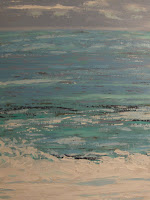
Today’s Image is the graphic used for the Orbisplanis Art Blog. It is a photo (not a painting as some suspected) taken from a vantage point near a very famous art museum.
In a way, an art blog is an unusual thing. The context of an art blog should be about art, right? You would/should expect to see pictures, images, paintings, designs, photos or something visual anyway.
But and however, the context of a blog is all about blogging (web logging to be exact), which means communicating. Of course, there are all kinds of ways to communicate both verbally, written, and visually. Maybe artists who blog are in a different category or should be.
Art and blogging may be two of those activities that don’t seem to go together at first. That brings up the old discussion of left brain/right brain, and is one side (either the creative or the pragmatic) dominant? Well, yes and no. Yes, they can go together, and no, one side does not have to be dominant (although that is the case in most people). Like technical writing, where author meets engineer, in art blogging, artist meets writer or vice versa or whatever, you get the picture (pun intended).
Is art blogging an oxymoron? Can you “art” and “blog” simultaneously? The answer is yes. There are thousands (at least) of art blogs on the internet. I’m assuming that many of those are created by artists who can write and conversely by writers who can “art.” If you have searched for and/or looked up many art blogs, you’ve already discovered that there are as many kinds of art blogs as there are art and artists (and that’s a whole lot).
Some art blogs are very personal and art-y. They seem to say, “look at me, I am a creative person, just look at my work and how wonderful it is.”
Some art blogs are more art than blog. Make that art business. They’re mostly a collection of an artist’s work, such as it is, and not much more. They say, “Here’s everything I’ve ever drawn/painted/sculpted etc. Interested? Please buy something.”
Many are How-To art blogs. This is the blog where we presume the artist has been trained in whatever subject or technique he/she is trying to teach you. There may be step-by-step processes, or in many cases, they’re a video that you can play over and over and over again, as if watching it was all that was needed to teach you to “art.” They say, “Watch this, and here’s everything you ever need to know about watercolor/ oil/ still life/portraits/ etc., etc. and aren't you the lucky one to have found it.”
Other art blogs are more of a philosophical nature. They may have a sense of drama and an aura about them as if art were some kind of supernatural experience that comes over both the artist and the viewer. When you read them, you may think that art and the ambiance of the art experience will take you away to some other world inhabited only by the ‘creative ones.’ They say something like, “if you read this blog you, too, will discover that art is Zen and Zen is art (or some such).”
So, what should an art blog aspire to be? As in art, the value of the art blog is in the eye of the beholder or in this case, the viewer/ reader.
I do firmly believe, however, that creativity is the glue. Any feedback on this subject from interested viewers will be appreciated.


















